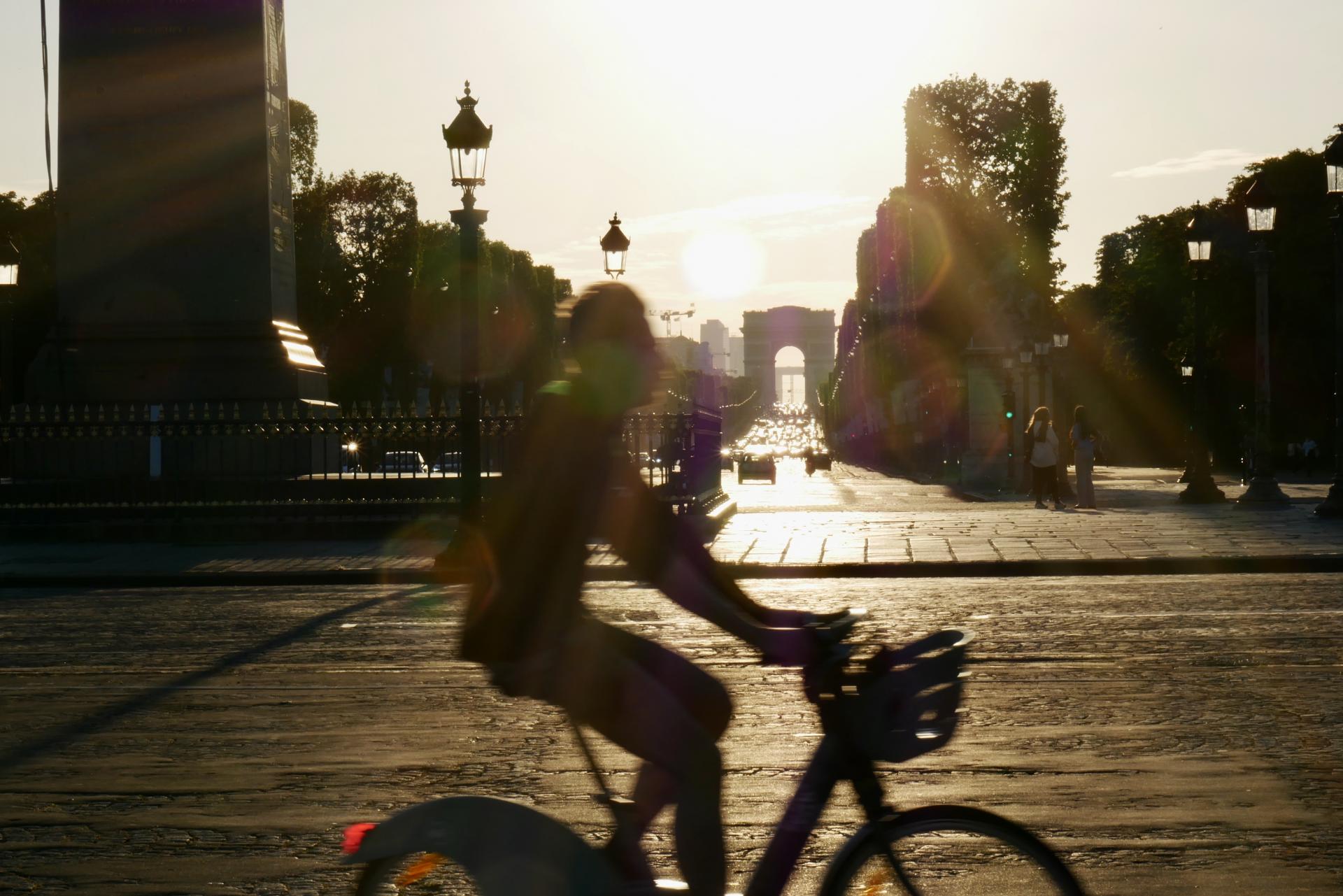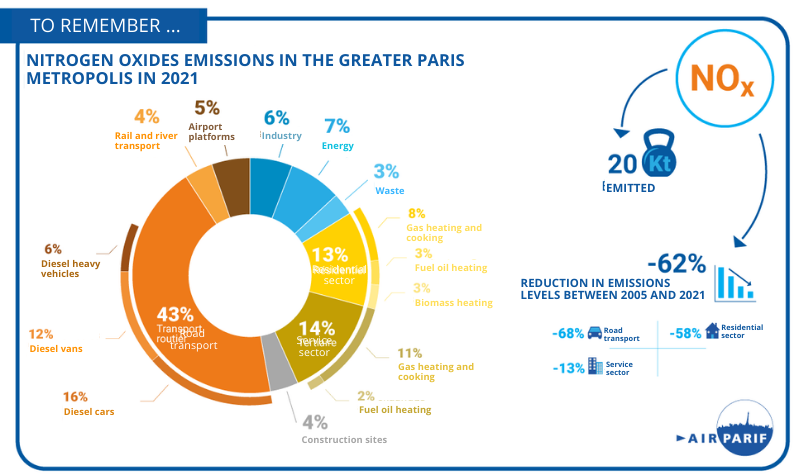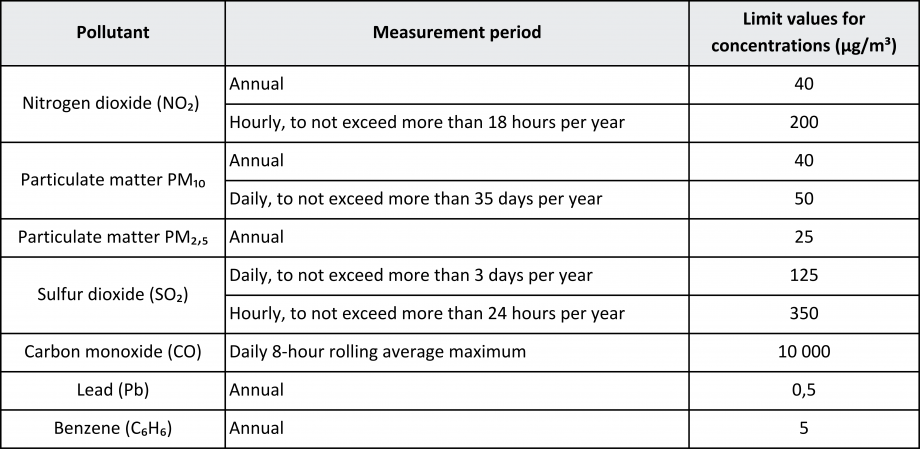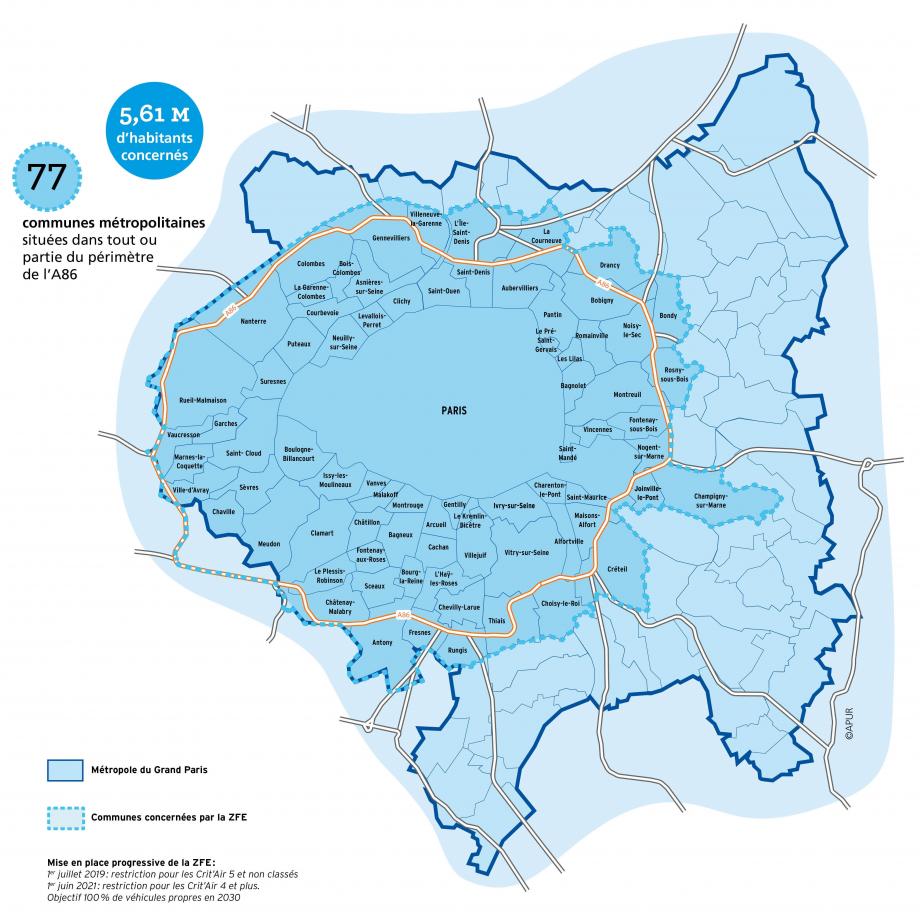
Air quality
Understand everything about air quality
Definitions
The Law on Air and the Rational Use of Energy (LAURE), voted and promulgated in 1996, asserts the right “to breathe an air that does not harm one’s health”. It defines air pollution as follows
“Constitutes atmospheric pollution within the meaning of this law the introduction by man, directly or indirectly, into the atmosphere and within enclosed spaces, of substances that have harmful consequences likely to endanger human health, to harm biological resources and ecosystems, to influence climate change, to damage material goods, to cause excessive olfactory nuisances.”
Air is a mixture of gases, mainly composed of nitrogen (N2) and oxygen (O2). “Atmospheric pollutants” are added to this mix, mainly as a result of human activities (road traffic, heating, industrial activities, etc.). Natural phenomena can also contribute to the deterioration of air quality (forest fires, dispersal of sand and dust, volcanic eruptions, etc.).
Concentrations of atmospheric pollutants, which characterize the air we breathe, depend on both pollutant emissions and weather conditions (atmospheric pressure, temperature, wind direction and speed, etc.).
Air quality monitoring
Since the LAURE law of 1996, the monitoring of ambient air quality has been entrusted to the Approved Air Quality Monitoring Associations (AASQA). Airparif is the AASQA responsible for monitoring air quality in the Ile-de-France region. The air quality monitoring mission is carried out by using modeling tools and the integration of measurements taken by the network of measuring stations distributed throughout the Ile-de-France region. Its aim is to quantify the chronic pollution to which the population is exposed, but also to predict and provide information on acute pollution via forecasting for the current day and one that follows.
Real-time pollution maps represent concentration levels for regulated and harmful pollutants in the Ile-de-France region: nitrogen dioxide (NO2), particulate matter (PM10 and PM2.5) and ozone (O3). A global index indicator (ATMO index), broken down into 6 levels, from “good”, “average”, “degraded”, “bad”, “very bad” to “extremely bad”, is produced by grouping the levels of pollutants cited above. The partnership between the Greater Paris Metropolis and Airparif makes it possible to strengthen knowledge on atmospheric pollutants and the state of air quality, and to evaluate the impact of public policies on air quality within the territory of the Greater Paris Metropolis.
Air pollutants and their sources
1. Nitrogen dioxide (NO2) is a pollutant mainly linked to combustion activities. In 2019, Airparif estimated that road traffic contributed to 45% of nitrogen oxide (NOx) emissions within the Greater Paris Metropolis. While the average annual concentration of NO2 in the air has fallen by more than 40% between 2012 and 2022, 40,000 inhabitants of the Greater Paris Metropolis continue to breathe a polluted air that exceeds the annual limit value for NO2 (40 µg/m3).


2. Particulate matter pollutants (PM2.5 and PM10) are a mixture of chemical compounds of varied sizes. PM10 particles have a diameter of less than 10 µm and PM2.5 particles, also called “fine particles”, have a diameter of less than 2.5 µm. The sources of these particles are diverse: the residential sector (wood heating), road traffic, construction sites, etc. Airparif notes a drop of more than 30% in average annual concentrations of PM10 and PM2.5 in background urban monitoring sites between 2012 and 2022 in the Greater Paris Metropolis. However, the objectives for human health, set out in French regulations and WHO recommendations, are still exceeded.


3. Other pollutants, also linked to human activity, contribute to the deterioration of air quality within the Metropolis, such as ozone (O3). Data and reports on atmospheric pollutants and greenhouse gas emissions are available on the Airparif website.
The impacts of air pollution on human health and the environment:
1. A major public health issue:
Air pollutants can cross the human body's natural defense barriers and thus reach the respiratory tract, bronchi and heart, with harmful effects on health. According to the Regional Health Observatory, more than 7,900 deaths could be avoided annually in the Ile-de-France region if the threshold values of the World Health Organization were reached. Exposure to air pollution promotes the development of respiratory pathologies (bronchitis, asthma) and cardiovascular pathologies, as well as some cancers. The World Health Organization notes that a growing number of studies highlight a link between exposure to air pollution and certain neurodegenerative pathologies. Air pollution is therefore a major public health issue.
2. Significant environmental and economic impacts :
Air pollution contributes to the eutrophication of soils through the deposition of nitrogen, to their acidification and to a lower ability of plants to store CO2. More generally, it contributes to the degradation of ecosystems and the decline in agricultural yields. In addition, air pollution deteriorates buildings, through the blackening of facades and the corrosion of limestone surfaces, for example. Finally, air pollution and climate change are two closely related issues: the main sources of air pollution and greenhouse gases are the same ones. The Airparif report “Air pollution and climate change: a common cause” explains these interactions in more detail.
In 2015, the senatorial report “Air pollution: the cost of inaction” estimated the economic and financial costs attributable to air pollution annually in France at 101.3 billion euros.
The regulatory framework :
Limit values are defined in the Environmental Code as “the levels to be reached within a given time frame and not to be exceeded and set on the basis of scientific knowledge in order to avoid, prevent or reduce harmful effects on human health or the environment as a whole”. These limit values are set in European law by Directive 2008/50/EC and have been transposed into French law by article R 221-1 of the environmental code and by the decree of April 16, 2021 relating to the national ambient air quality monitoring system

A draft revision of Directive 2008/50/EC was adopted by the European trilogue, in order to set lower limit values, to be achieved by January 1, 2030. Concerning NO2, the annual limit value will therefore be lowered to 20 µg/m3 from 2030.
Litigation
Concluding that "France has systematically and persistently exceeded the annual limit value for nitrogen dioxide since January 1, 2010" in 12 surveillance zones, including Paris, the Court of Justice of the European Union condemned the French state in 2019. After convictions in 2021 and 2022 leading to the payment of two fines of 10 million euros, the Council of State in a decision rendered in November 2023 sentenced the State to two fines of 5 million euros, given the exceeding of regulatory thresholds for nitrogen dioxide in the urban areas of Paris and Lyon.
Plans to improve air quality in Ile-de-France
At the regional level, the Ile-de-France Atmosphere Protection Plan (PPA) is a planning tool aimed at improving air quality in the Ile-de-France region. The Greater Paris Metropolis has validated a territorialized strategy with its Metropolitan Climate Air Energy Plan (PCAEM) adopted by the Metropolitan Council on November 12, 2018. Improving air quality is among its priorities
The Metropolitan Low Emission Zone
The Greater Paris Metropolis is committed to improving air quality.
The Greater Paris Metropolis must respond to a health and climate emergency. According to Airparif's 2022 report, the annual limit value for nitrogen dioxide (NO2) concentrations continues to be exceeded in the Greater Paris Metropolis, as well the WHO recommendations for air quality. The Ile-de-France Regional Health Observatory estimates that 7,900 deaths could be avoided each year in Ile-de-France if WHO recommendations were respected.
On October 24, 2019, France was condemned by the Court of Justice of the European Union for having “systematically and persistently” exceeded the annual limit value for nitrogen dioxide (NO2). After convictions in 2021 and 2022 leading to the payment of two fines of 10 million euros, the Council of State in a decision rendered in November 2023 again sentenced the State to two fines of 5 million euros, due to the exceeding of regulatory thresholds for nitrogen dioxide in the urban areas of Paris and Lyon. The Council of State ordered the government to take all necessary measures to improve air quality.
The Greater Paris Metropolis has validated a strategy with the Metropolitan Climate Air Energy Plan, definitively adopted by the Metropolitan Council on November 12, 2018. The improvement of air quality is among its priorities.
To achieve this, the establishment of a metropolitan low emission zone (LEZ) was evaluated within the framework of the Île-de-France Atmosphere Protection Plan as having the most significant impact. This was confirmed in 2018 by the Regional Health Observatory (ORS-IdF). This measure is not intended to make the Greater Paris Metropolis a car-free zone but to accelerate the renewal of the vehicle fleet, in addition to the financial support scheme currently in force. Its benefits extend well beyond that : it improves the quality of life, makes the territory more attractive and helps to reduce noise pollution
What is a Low Emission Zone (LEZ) ?
A LEZ is intended to protect inhabitants in the most polluted urban areas. Already adopted in 315 European cities, it is recognized as particularly effective in reducing emissions from road traffic, one of the main sources of air pollution in cities. Its principle: to encourage the circulation of the cleanest vehicles. To travel in a LEZ, the Crit’Air sticker must be affixed to the windshield. It makes it possible to distinguish vehicles according to their level of air pollutant emissions. The most polluting vehicles and the “unclassified” ones are not able to drive in the LEZ during certain time slots..
AID AND ALTERNATIVES
The establishment of the LEZ is accompanied by a financial support scheme for vehicle renewal. Patrick Ollier, president of the Greater Paris Metropolis, has made a commitment to this end by establishing, in conjunction with the State, the City of Paris and the Region, a one-stop shop for aid. Cumulatively, this aid can go up to 22,000 euros for the purchase of a new clean vehicle, and up to 16,000 euros for the purchase of a used clean vehicle. The aid from the Metropolis can be combined with the State conversion bonus and the ecological bonus. The “Métropole Roule Propre !” scheme, which allows financial support of up to €6,000, depending on household income, allows metropolitan inhabitants to replace their polluting vehicle, regardless of the type of engine, with a clean vehicle.
The aid from the Metropolis can be combined with the State conversion bonus and the ecological bonus. The “Métropole Roule Propre !” scheme, which allows financial support of up to €6,000, depending on household income, allows metropolitan inhabitants to replace their polluting vehicle, regardless of the type of engine, with a clean vehicle.
Concerned cities by Low Emission Zone (LEZ) inside the Intra A86 area

Métropole Roule Propre
The Greater Paris Metropolis has made air quality one of its priorities since its creation in 2016. You can benefit from assistance in renewing your old vehicle ranging from :
- Up to €6,000 for the purchase of a new or used vehicle: electric, hydrogen, hybrid or natural gas ;
- Up to €1,400 for the purchase of a 2-wheeler, 3-wheeler, electric quadricycle ;
- Up to €500 for the purchase of an electric bike.
This scheme can be combined with the conversion bonus and the ecological bonus.

Deployment of 5,000 electric charging stations
Thanks to Métropolis, the Greater Paris Metropolis, committed to sustainable mobility, is deploying electric charging stations in the 130 municipalities within its perimeter.
"The Greater Paris Metropolis facilitates the emergence of a charging offer for electric vehicles with a relevant network, economically robust and understandable for its users. The establishment of this network on public roads, based on the principles of territorial continuity and equal treatment between municipalities, is essential to respond to the electrical charging problem faced daily by residents and the professionals of the Métropole” indicates Patrick Ollier, President of the Métropole.
Ultimately 5,000 charging points will be installed, including 250 that will be dedicated to rapid on-road charging. A strong commitment from the metropolitan recovery plan.
The grouping of French companies Métropolis (composed of SPIE CityNetworks, E-TOTEM and SIIT) has been named winner of the call for private initiatives for the installation and operation of charging points for electric vehicles on roads in the municipalities of the Metropolis (excluding Paris) in May 2020.
Carbon Cooperative
Companies, communities, NGOs, researchers or individuals: join the governance of the Paris-Métropole Carbon Cooperative !
As an intermediary between financing organizations and project leaders, the Carbon Cooperative will allow green transition actors in search of financing to highlight their actions and will allow everyone – institutions, companies, federations, organizers of major events and citizens – to contribute financially to the development of these projects. It will activate several levers to promote projects : carbon compensation (via the Low-Carbon label), Energy Savings Certificates and crowdfunding. On the other hand, the Carbon Cooperative will develop a local label, offering opportunities to finance urban projects while providing sufficient guarantees and rigor on the environmental integrity of the projects.
In accordance with the objectives of the Paris Agreement, the establishment of the Carbon Cooperative encourages and facilitates eco-responsible approaches by companies and public entities and allows citizens to act directly on their territory. The City of Paris and the Greater Paris Metropolis invite you to participate in the governance and launch of a structure promoting the mobilization of financing for the ecological transition of the territory.
Under the format of a Cooperative Society of Collective Interest (SCIC), the Territorial Carbon Cooperative brings together the expertise and commitment of a panel of stakeholders around a common objective of achieving carbon neutrality in the territory.
A Call for Expressions of Interest made it possible to bring together the first economic players to form the college of “Investors”. Today, we are calling on all types of actors wishing to participate in the governance and development of the Territorial Carbon Cooperative, in order to form four other colleges: “Users, clients and beneficiaries”, “Associated local authorities”, “ Employees, Producers of goods/services” and “Experts, Researchers, Associations and Volunteers”.
